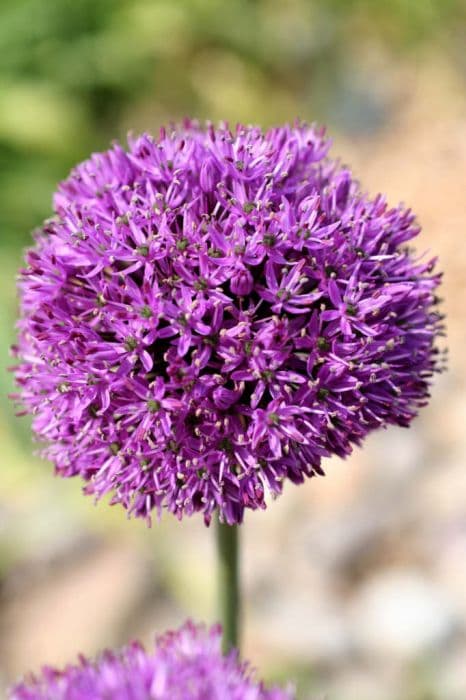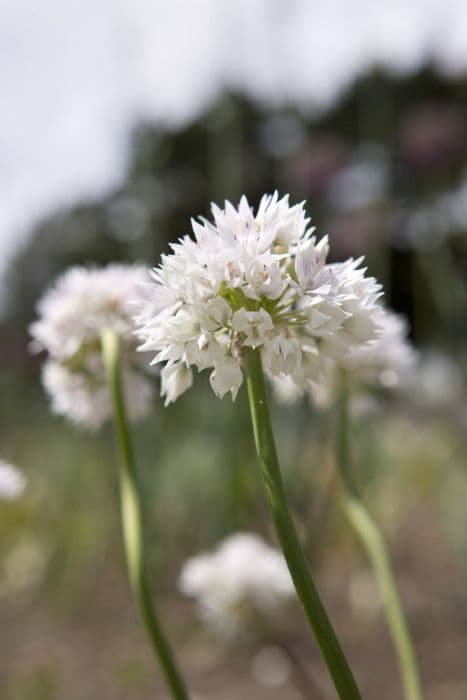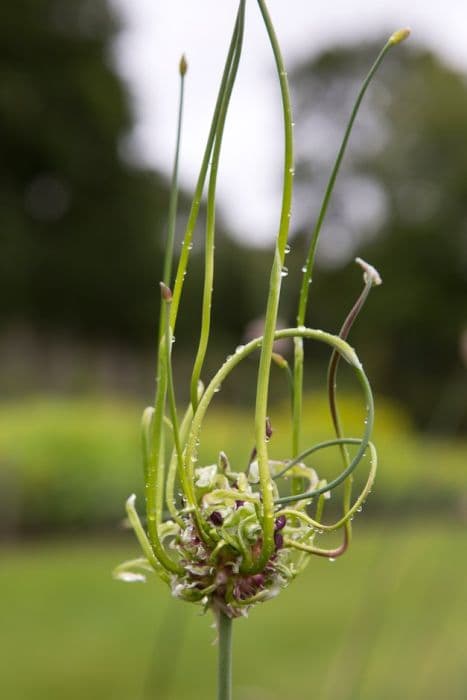Persian onion Allium hollandicum

ABOUT
Allium hollandicum, commonly known as Persian onion, exhibits a striking visual appeal. This ornamental plant is distinguished by its spherical flower heads that boast a dense cluster of star-shaped, purple flowers. These flowers are perched atop sturdy, slender stems, creating an elegant display reminiscent of a fireworks burst. The foliage of the Persian onion consists of narrow, strap-like green leaves that typically wilt before the flowers come into full bloom, ensuring that the dramatic floral display commands attention. The plant emits a subtle onion-like fragrance when the leaves are crushed or bruised. Overall, the Persian onion is prized for its vibrant color and unique, spherical flower form, making it a favorite in garden borders and floral arrangements.
About this plant
 Names
NamesSynonyms
Persian Onion, Dutch Garlic, Ornamental Onion
Common names
Allium hollandicum has no known synonyms; therefore, the basic scientific name is Allium hollandicum.
 Toxicity
ToxicityTo humans
Persian onion (Allium hollandicum) is not typically considered toxic to humans. However, as with other members of the Allium family, ingestion in large quantities may cause gastrointestinal upset, such as nausea, vomiting, or diarrhea. Sensitivity can vary from person to person, so it is wise to consume it in moderation and be cautious if you have a known sensitivity to Allium species.
To pets
Persian onion (Allium hollandicum) is toxic to pets, particularly cats and dogs. The Allium family contains compounds that can cause oxidative damage to red blood cells, leading to hemolytic anemia. Symptoms of poisoning in pets may include vomiting, diarrhea, abdominal pain, lethargy, elevated heart rate, weakness, and collapse. In severe cases, ingestion can result in jaundice, red-colored urine, or even death if not treated promptly. Owners should prevent their pets from ingesting any part of this plant and seek veterinary care if they suspect poisoning.
 Characteristics
CharacteristicsLife cycle
Perennials
Foliage type
Deciduous
Color of leaves
Green
Flower color
Purple
Height
2-3 feet (60-90 cm)
Spread
1 foot (30 cm)
Plant type
Bulb
Hardiness zones
5
Native area
Asia
Benefits
 General Benefits
General Benefits- Ornamental Appeal: Allium hollandicum, commonly known as Persian onion, produces attractive spherical purple flowers that add visual interest to gardens and landscapes.
- Pollinator Attraction: The flowers of the Persian onion are known to attract bees, butterflies, and other pollinators, supporting local ecosystems.
- Drought Tolerance: Persian onion is quite resistant to drought, making it suitable for xeriscaping and low-water gardens.
- Low Maintenance: It requires minimal care once established, making it a good choice for gardeners seeking low-maintenance plants.
- Pest Resistance: This plant is generally resistant to pests, reducing the need for chemical pest control.
- Easy Propagation: Persian onion can easily be propagated through bulb division, allowing gardeners to expand their plantings or share with others.
- Deer and Rodent Resistance: The plant is typically not favored by deer or rodents, helping to prevent damage to garden plants.
- Seasonal Color: With its late spring to early summer blooms, Allium hollandicum provides a splash of color after many spring flowers have faded.
- Edible Parts: Although not its primary benefit, some parts of the plant are edible, like the bulbs and flowers, offering a mild onion or garlic flavor.
- Long-lasting Blooms: The flowers of Persian onion remain attractive for an extended period, even after they have finished blooming, adding interest to dried floral arrangements.
- Structural Diversity: The plant's tall stems and globular blooms provide structural diversity within garden beds and borders.
 Medical Properties
Medical PropertiesThis plant is not used for medical purposes.
 Air-purifying Qualities
Air-purifying QualitiesThis plant is not specifically known for air purifying qualities.
 Other Uses
Other Uses- Allium hollandicum, commonly known as Persian onion, can be used in floral arrangements for its striking spherical blooms and long stems, providing a unique architectural element.
- The dried seed heads of the Persian onion can be used in crafts or as decoration in bowls and centerpieces for their interesting texture and shape.
- Persian onion plants serve as excellent companions in the garden, helping to deter common pests that might target other plants.
- The plant's tall and sturdy stalks can serve as natural supports for other, more delicate flowers in the garden.
- The nectar of the Persian onion is attractive to beneficial pollinators such as bees and butterflies, making it a useful addition to a pollinator-friendly garden.
- You can use the aesthetic qualities of Persian onion to create a dramatic garden border that peaks in late spring to early summer.
- The leaves of the Persian onion can be used in small quantities as a flavoring agent, similar to chives, in culinary applications.
- The plant can be grown in containers to decorate patios and balconies, adding height and visual interest with its globe-like blooms.
- Persian onion can be applied in landscape design, as its distinct form contrasts well with low-growing groundcovers for a varied texture.
- As a natural colorant, the pigments from the bright purple flowers of Persian onion can be used to create botanical dyes for fabrics or paper.
Interesting Facts
 Feng Shui
Feng ShuiThe Persian Onion is not used in Feng Shui practice.
 Zodiac Sign Compitability
Zodiac Sign CompitabilityThe Persian Onion is not used in astrology practice.
 Plant Symbolism
Plant Symbolism- Unity and Humility: The Allium hollandicum, commonly known as the Persian Onion, often symbolizes unity due to its many small flowers that make up the spherical inflorescence, representing the coming together of many parts to form a whole.
- Good Fortune and Prosperity: In some cultures, the impressive round shape of the Persian Onion's flowers is associated with wealth and abundance, making it a symbol of good luck and prosperity.
- Patience and Perseverance: As alliums can take a while to bloom after being planted, they can symbolize patience and the ability to persevere through difficult circumstances.
- Strength and Endurance: The sturdy stems and robust nature of the Persian Onion illustrates strength and the capacity to endure challenges, reflecting its ability to stand tall and not falter in harsh conditions.
 Water
WaterThe Persian onion, commonly known as Allium hollandicum, requires moderate watering. During the growing season, it typically needs to be watered once a week with about one to two gallons of water per square yard. Ensure you water deeply to encourage root growth and allow the soil to dry out slightly between waterings. Over-watering or allowing the plant to sit in water can lead to bulb rot, so it is crucial to have well-draining soil. Adjust the watering schedule during periods of rainfall or drought.
 Light
LightThe Persian onion thrives best in full sunlight conditions. It should be planted in a spot that receives at least six hours of direct sunlight daily. Although it can tolerate partial shade, the amount of bloom may be reduced in less than ideal sun exposure, and the plant's overall health could be compromised.
 Temperature
TemperatureThe Persian onion prefers a temperature range typical of temperate climates. It can survive winter temperatures down to about 5 degrees Fahrenheit but should be protected from the harsh, cold weather if temperatures drop much lower. The ideal temperature range for this plant is between 50 and 75 degrees Fahrenheit, which allows for optimal growth and flowering.
 Pruning
PruningPruning of the Persian onion is generally done for aesthetic purposes and to prevent self-sowing if desired. After flowering, you can deadhead the spent blooms to maintain appearance and direct the plant's energy back into bulb growth. Pruning is typically carried out after the leaves and stems have turned yellow and begun to wither, which is often in late summer.
 Cleaning
CleaningAs needed
 Soil
SoilPersian Onion prefers well-draining soil with a high content of organic matter. A soil mix of garden soil, compost, and sand works well, ensuring efficient drainage and nutrient content. The soil pH should be within the neutral range of 6.5 to 7.0 for optimal growth.
 Repotting
RepottingPersian Onion, being a bulbous plant, does not require frequent repotting. Repotting is generally only necessary if the bulbs overcrowd the container or show signs of decline. This typically happens every 3 to 5 years.
 Humidity & Misting
Humidity & MistingPersian Onion is not particularly sensitive to humidity and can thrive in average ambient humidity levels found in most outdoor environments. No special humidity requirements are needed for this plant.
 Suitable locations
Suitable locationsIndoor
Grow Persian Onion in a sunny spot with well-draining soil mix.
Outdoor
Plant in well-drained soil and full sun, space bulbs 20cm apart.
Hardiness zone
5-8 USDA
 Life cycle
Life cycleAllium hollandicum, commonly known as Persian onion, begins its life cycle when a seed germinates in late summer or autumn. The seed develops a root system and a small bulb, which will remain dormant during the winter. In spring, leaves emerge and photosynthesis enables the bulb to grow; a tall stem then arises, culminating in a spherical cluster of star-shaped flowers. After flowering, which usually occurs from late spring to early summer, the plant sets seed; the flowers fade, and the foliage dies back. The seeds disperse, and the bulb enters a period of dormancy during the summer heat. The cycle restarts with the germination of new seeds or the regrowth of the bulb the following autumn.
 Propogation
PropogationPropogation time
Spring
Propogation: The most popular method to propagate Allium hollandicum, commonly known as Persian onion, is through division of its bulb clusters. This is typically done in late summer or early fall after the foliage has died back. Gardeners carefully dig up the bulbs and gently separate them into individual ones, making sure each bulb has a portion of the root system attached. After division, the bulbs are replanted at a depth of around 3 inches (approximately 7.6 centimeters) and spaced about 8 to 12 inches apart (20 to 30 centimeters) to allow for ample growing space. Watering the newly planted bulbs helps establish them, but it's important to avoid overwatering as this could cause the bulbs to rot.








